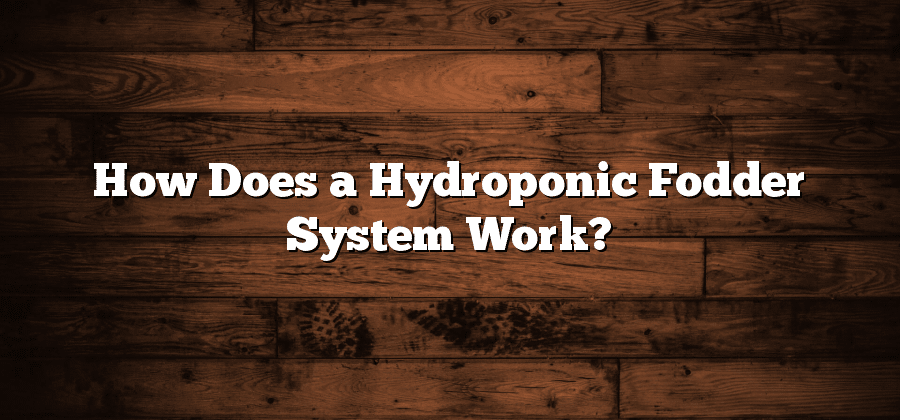Benefits of a Hydroponic Fodder System
Hydroponic fodder systems offer numerous benefits for agricultural enthusiasts and livestock farmers. One of the key advantages is the year-round availability of fresh and highly nutritious feed for livestock. Unlike traditional farming methods that are heavily reliant on weather conditions and seasonal limitations, hydroponic fodder systems enable farmers to grow fodder consistently, ensuring a steady supply of essential nutrients for their animals. This not only improves the overall health and well-being of livestock but also contributes to increased productivity and profitability in the long run.
In addition to providing a constant source of feed, hydroponic fodder systems require significantly less water compared to conventional farming methods. By utilizing a controlled environment and recirculating water systems, these systems are able to optimize water usage and reduce the overall environmental impact. This is particularly beneficial in regions where water scarcity is a significant concern. Moreover, the efficient water usage of hydroponic fodder systems helps to minimize water wastage, making them a sustainable and eco-friendly option for feeding livestock.
Components Required for a Hydroponic Fodder System
Hydroponic fodder systems require several key components to ensure optimal growth and production. The first essential component is a *growth tray* or *container* that acts as the base for the system. These trays should be durable and provide adequate space for the roots to grow. Additionally, a *lighting system* is crucial for supplying the necessary light spectrum for photosynthesis. LED lights are commonly used in hydroponic systems as they are energy-efficient and can be customized to meet the specific needs of the plants. Another important component is the *nutrient solution*, which serves as the primary source of nutrients for the plants. This solution should be properly formulated to provide the necessary macronutrients and micronutrients required for healthy growth. pH and EC meters are also essential for measuring the acidity and nutrient levels in the solution to maintain optimal conditions for the plants.
Another crucial component for a hydroponic fodder system is the *irrigation system*. This system ensures that the plants receive the right amount of water and nutrients at regular intervals. A drip irrigation system or a hydroponic mat can be used to distribute the nutrient solution evenly across the growth trays. It is important to monitor the moisture levels in the growing trays to prevent overwatering or underwatering the plants. Lastly, ventilation and air circulation systems are essential to maintain optimal airflow and prevent the buildup of excess moisture, which can lead to the growth of mold or other pathogens. A combination of exhaust fans and air vents can help regulate temperature and humidity levels within the growing area.
These components are essential for setting up a successful hydroponic fodder system. Proper selection and installation of these components will ensure that the plants receive the necessary conditions for healthy growth and maximum production.
Selecting the Right Seeds for Hydroponic Fodder
When it comes to selecting the right seeds for a hydroponic fodder system, there are a few key factors to consider. First and foremost, it is essential to choose seeds that are specifically bred or selected for hydroponic cultivation. These seeds are often referred to as “hydroponic seeds” or “sprouting seeds.” They are specifically designed to thrive in water-based growing systems, ensuring optimal growth and nutrient uptake.
In addition to choosing hydroponic-specific seeds, it is important to select varieties that are well-suited for fodder production. Look for seeds of fast-growing and highly nutritional crops such as barley, wheat, oats, or alfalfa. These crops have been found to be particularly beneficial for livestock and can provide a rich source of vitamins, minerals, and proteins. Additionally, consider the specific nutritional requirements of the animals that will consume the hydroponic fodder and select seeds accordingly.
By carefully selecting the right seeds for your hydroponic fodder system, you can ensure that your livestock receive a highly nutritious and abundant food source. Keeping in mind the specific needs of hydroponic cultivation and the nutritional requirements of the animals, choosing hydroponic seeds that are specifically bred for fodder production can contribute to a successful and efficient hydroponic system.
Preparing the Growing Area for Hydroponic Fodder
When it comes to preparing the growing area for a hydroponic fodder system, there are several important factors to consider. First and foremost, it is crucial to ensure that the area is clean and free from any contaminants or pests that could potentially harm the crops. This can be achieved through regular cleaning and disinfection, as well as the implementation of proper pest control measures. Additionally, the growing area should be well-ventilated to provide an optimal environment for the plants. Adequate ventilation helps to maintain the right temperature and humidity levels, which are crucial for the growth and development of the fodder crops.
Another vital aspect of preparing the growing area is selecting the appropriate lighting system. Since hydroponic fodder systems are typically grown indoors, artificial lighting plays a crucial role in providing the necessary light energy for photosynthesis. The type and intensity of lighting depend on the specific requirements of the chosen crop. It is important to select lighting systems that offer a spectrum of light suitable for plant growth and ensure that the plants receive adequate light exposure throughout the day. Additionally, proper installation and arrangement of the lighting fixtures are necessary to ensure uniform light distribution across the growing area.
Without a doubt, preparing the growing area for a hydroponic fodder system requires careful consideration and attention to detail. By ensuring cleanliness, ventilation, and proper lighting, growers can create an optimal environment for the crops to thrive. The next step in the hydroponic fodder cultivation process is selecting the right seeds, which play a critical role in determining the success of the system.






